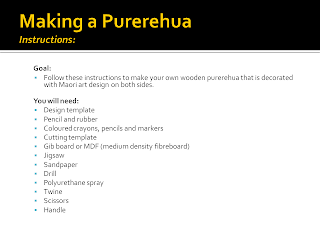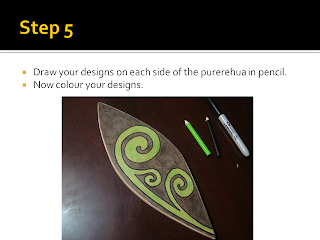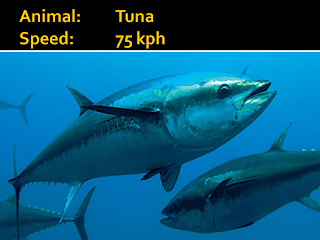Fortunately we have been practicing and playing rugby at lunchtimes for the last few weeks, because we have just entered a school team into the Winter Tournament in Week 11. It is a 7-a-side competition and we have a squad of 12.
We'll be focusing on some simple strategies over the next couple of weeks - ensuring that all players can support the ball carrier and retain possession at rucks, and creating some plays from scrums using our big, fast runners. Good luck team!
Reflections on my Teaching Experience at Room 3, Hokowhitu School. Contact me at chris.ricketts@gmail.com
Thursday, September 20, 2012
Monday, September 17, 2012
Purerehua
Purerehua are musical instruments used by Maori to communicate, call out lizards from the bush, for ceremonies, and as rainmakers. The idea to make these came from a science experiment where we studied the sound produced when you tie a ruler to a piece of string a twirl it around. Children asked if we could make real ones.
I have created an art unit (visual art) where we will learn to make purerehua out of wood. There is a strong link to tikanga maori as we will study the traditional uses and materials used, and also examine examples of maori art design which we will incorporate into the art to decorate the purerehua.
I have created an art unit (visual art) where we will learn to make purerehua out of wood. There is a strong link to tikanga maori as we will study the traditional uses and materials used, and also examine examples of maori art design which we will incorporate into the art to decorate the purerehua.
Here is a slideshow resource I made for lesson 1 of the unit. Subsequent lessons involved the completion of the artwork.
The link on the opening slide is: http://www.youtube.com/watch?v=zL4Yq5S1gTY
Wednesday, September 12, 2012
Speed
I have created a unit of mathematics on the subject of measurement for the 'Happy Feet' maths group. I wanted to include measurements that students could relate to, and with the Olympics having just concluded, I designed one of the lessons on speed. We learned to measure our running speed (using distance and time) and compare them to 100m Olympic Champion Usain Bolts!
We calculated that Usain Bolt runs at a top speed of 45kph, whereas the fastest student in Room 3 managed only 20kph! That got us thinking.... what speeds can other animals such as the cheetah run at? What about birds, or even fish? Here is what we found. Happy Feet co-wrote and presented this slideshow to the rest of the school at assembly.
Enthusiastic 3 have been investigating speed in
our maths class. We thought it would be fun to compare the speeds of different
animals. Here’s what we found.....
Let’s start with our old friend the tortoise. A
real slowcoach, he can only travel 300 metres in 1 hour. Don’t bother sending
him to the dairy for ice creams!
Chickens can’t run can they? Well yes they can,
but only at modest speeds of around 15 kph. Bukerrrrrrk!!!
Yes, we are a bunch of animals. Room 3 students
reached speeds of 20 kph. That’s fast enough to catch a chicken. Who needs KFC!
This is very worrying! With a top speed of 32
kph the Black Mamba snake can easily outrun, or should that be ‘outslither’ a
room 3 student!
How about Olympic champion Usain Bolt? His world
record time for the 100 metres is 9.58 seconds! If he gave the fastest runner
in Room 3 a 50 meter head start, he’d still win a 100m race!
This is not a fishy tale! The Tuna can swim at
over 75 kph. It could swim all the way to Wellington and back home in time for
lunch!
The Cheetah is the fastest animal on land and
can reach speeds of 113 kph! That’s fast enough to get a speeding ticket on the
Wellington motorway!
Finally
– the king of speed. The Peregrine Falcon makes all other animals look like
slow coaches with a top speed of 349 kph. At that speed a flight down to
Wellington would take only 24 minutes!
We hope you enjoyed our presentation! And remember, you may be faster than a chicken, but you are slower than a Tuna!
We hope you enjoyed our presentation! And remember, you may be faster than a chicken, but you are slower than a Tuna!
Wednesday, September 5, 2012
Sound and Writing
I have created a unit of work that combines literacy (procedural writing) and science (investigations into sound). I felt that learning to write instructions would be more authentic if students actually devised the tasks themselves!
To hook the students into the investigation of sound I did a simple demonstration where we covered a bowl with gladwrap and poured some pepper on the gladwrap. Students then banged an oven tray with a wooden spoon around 5-10cm from the bowl. The pepper jumped! We wondered how this happened?
Students then created string telephones using tin cans, paper cups and simliar objects. They experimented by twanging the string with different intensities, changing the length of the string and the tension on the string. Some students joined a number of string telephones together to make a 'conference call'!
Students conducted other investigations into sound such as: making instuments out of a drinking straw; twanging a ruler on the edge of a desk; holding a baloon near a stereo speaker and twirling a ruler tied to a piece of string. For each experiment students wrote up a set of instructions so that a reader could follow their procedure.
Following our investigations, students created two big ideas to summarise our findings:
To hook the students into the investigation of sound I did a simple demonstration where we covered a bowl with gladwrap and poured some pepper on the gladwrap. Students then banged an oven tray with a wooden spoon around 5-10cm from the bowl. The pepper jumped! We wondered how this happened?
Students then created string telephones using tin cans, paper cups and simliar objects. They experimented by twanging the string with different intensities, changing the length of the string and the tension on the string. Some students joined a number of string telephones together to make a 'conference call'!
Students conducted other investigations into sound such as: making instuments out of a drinking straw; twanging a ruler on the edge of a desk; holding a baloon near a stereo speaker and twirling a ruler tied to a piece of string. For each experiment students wrote up a set of instructions so that a reader could follow their procedure.
Following our investigations, students created two big ideas to summarise our findings:
We also created instructions to guide us in our procedural writing:
Monday, September 3, 2012
Dance
Room 3 are dancing to 'Don't Stop me Now' by Queen as a part of the school's production later this month at the Regent Theatre. Local dance instructor Dean Mckerras has choreographed the song and taught it to the class. I am now coordianting rehersals and providing feedback to the class to fine-tune our performance.
Some key considerations are making the movements as big as possible so they are not lost on the huge stage. Also dancers need to be looking up so the crowd can all see their smiling faces! There is a section of the dance where everyone breaks into an air-guitar solo. We resarched famous guitarists like Slash from Guns 'n Roses to see how it is done. These photos are from rehersals in the school hall and outside the Regent Theatre following dress rehersal:
Some key considerations are making the movements as big as possible so they are not lost on the huge stage. Also dancers need to be looking up so the crowd can all see their smiling faces! There is a section of the dance where everyone breaks into an air-guitar solo. We resarched famous guitarists like Slash from Guns 'n Roses to see how it is done. These photos are from rehersals in the school hall and outside the Regent Theatre following dress rehersal:
Subscribe to:
Comments (Atom)
































